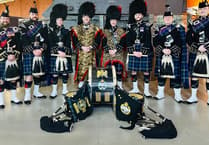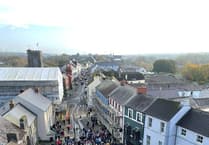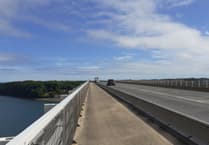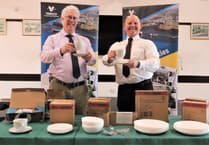Local History Fair
Saturday saw us participating at the Local History Fair held at Haverfordwest Library. The fair is an annual event in which heritage groups from all over Pembrokeshire participate to display their work and generally network. Our displays were centred around a theme which, this year, was Pembrokeshire 1900-1920.
Pembroke 1900
So what was Pembroke like at the beginning of the 20th Century? The town had not actually spread far beyond its mediaeval boundaries - it still consisted of one main street flanked by buildings constructed in burgage plots and contained within the old town walls. Nineteenth century expansion as a result of the building of the Royal Dockyard, Pembroke Dock, had led to the building of a suburb at Orange Gardens to the south of the town, while Monkton expanded westwards.
The Castle
Very noticeable would have been the state the castle which was in a much more ruinous state than today. Thanks to the antiquarian J. R. Cobb the barbican had been largely restored - it was left to Sir Ivor Phillips in the late 1920s to restore it to its present day magnificent state under the direction of talented architect Robert Childs. This is what Arthur L. Leach had to say in his 'Guide to Tenby' published at the turn of the century.
"Pembroke was anciently a walled town like Tenby, but while the latter has lost its castle and retained its walls, Pembroke has only slight and uninteresting remains of its town walls, but still makes proud boast of its magnificent castle - a splendid example of a Norman fortress. Several very ancient houses and ecclesiastical ruins stand on the hill-side below the extremely interesting Priory Church at Monkton, and bordering the 'common' some fragments of the town walls remain, but the unsavoury state of the neighbourhood hardly tempts the visitor to closer acquaintance with these mediaeval relics.'
The smelly Commons
So things have improved somewhat as the commons are considerably more salubrious today: its smelly past well and truly behind it. An industrial estate had developed on The Commons with a gasworks, limekiln, slaughter house (now the library), tannery (now the youth club), smithy and iron foundry (now the community centre): all in all, a toxic mix. It was also something of a dumping ground as well.
The Main Street
Pembroke Main Street, however, remains the one main shopping street - although, in 1900, it would have been a great deal busier. There could be found a whole range of businesses and trades - you really would have shopped local then; for there was everything you needed in the Main Street. The same could be said of Monkton. Although a parish of Pembroke, Monkton was quite separate, a close-knit community quite independent. It was self sufficient and boasted numerous shops covering every need from milliners to bakers.
Photographs of Main Street
In the two photographs of Main Street printed here can be seen prominent Pembroke businesses dating back to this time. The procession in the Main Street passes by (on the right of the photograph) Robert George and Sons, the wine and spirit stores, now McLaren's Hairdressers. Next door is the fine double fronted premises of R. H. Treweeks, Chemist, Bookseller and Stationer 'Prescriptions carefully dispensed with genuine drugs and chemicals', now Mendus. Further along is London House owned by Henry T. Pratt 'the London House for drapery, millinery, dressmaking, silk mercery, household linens, carpets (English and Foreign), linoleums and floor cloths. Ladies mantles, capes and jackets a speciality. Children's pelisses, tunics and overalls in great variety. Ladies underclothing and corset department well assorted and up-to-date with latest novelties ...' London House is now occupied by artist Adrian James and the Card Shop.
In the second photograph to the right of the Clock Tower was W. Simon 'Auctioneer, House and Estate Agent; corn, flour, manure, seed and provision merchant; high-class grocery in all its branches. Pure home-made, steam-baked bread and cakes delivered to all parts of the Town and County daily.' It was a terrible act of 1960s vandalism which replaced this lovely, Victorian shop front with the hideous modern, trashy exterior which is now the Co-op, but which was originally Fine Fare.
Transport
Parking was not a problem. You would have ridden along the Main Street on horse or bike, as cars were only just making an appearance. Steam was still king - travel was mainly by train which was still in its hey day and the sea was still an important highway. The Pembroke Quays were busy and ships engaged in the coastal trade were a common sight.
Agriculture
and the Fair
Pembroke was an important agricultural centre and market town: the right to hold markets and fairs was embodied in its Royal Charters dating back to the Middle Ages. The Michaelmas Fair, still held in the Main Street every October, was originally the annual hiring fair where bargains were struck with local farmers for a year's work and attracted farm workers from all over South Pembrokeshire. The fair also attracted traders and entertainers, Haggar's bioscope being a main attraction at this time. William Haggar was one of the pioneers of the cinema; the name Haggar is very much part of the story of Pembroke and some of his filming took place locally.
Community Life
In 1900, you would more likely than not have attended church or chapel and around them revolved social life for many. Community life was much stronger then, but life was a lot harder; working conditions could be harsh and there was little in the way of benefit to those out of work or widowed. Poverty was very real and for those made destitute there was the Pembroke Union Workhouse, part of which is still standing on the north shore of the Millpond.
I could go on and on - but space is limited. It is fortunate that we have a fine collection of photographs relating to this period.
Next event
On Saturday, October 6, John Brock will be giving a talk at our coffee morning in Monkton Priory Church Hall at 10.45 am. 'Wartime Carew with some Monkton memories as well'. The coffee morning runs from 10.30 - 1 and entry is free.




